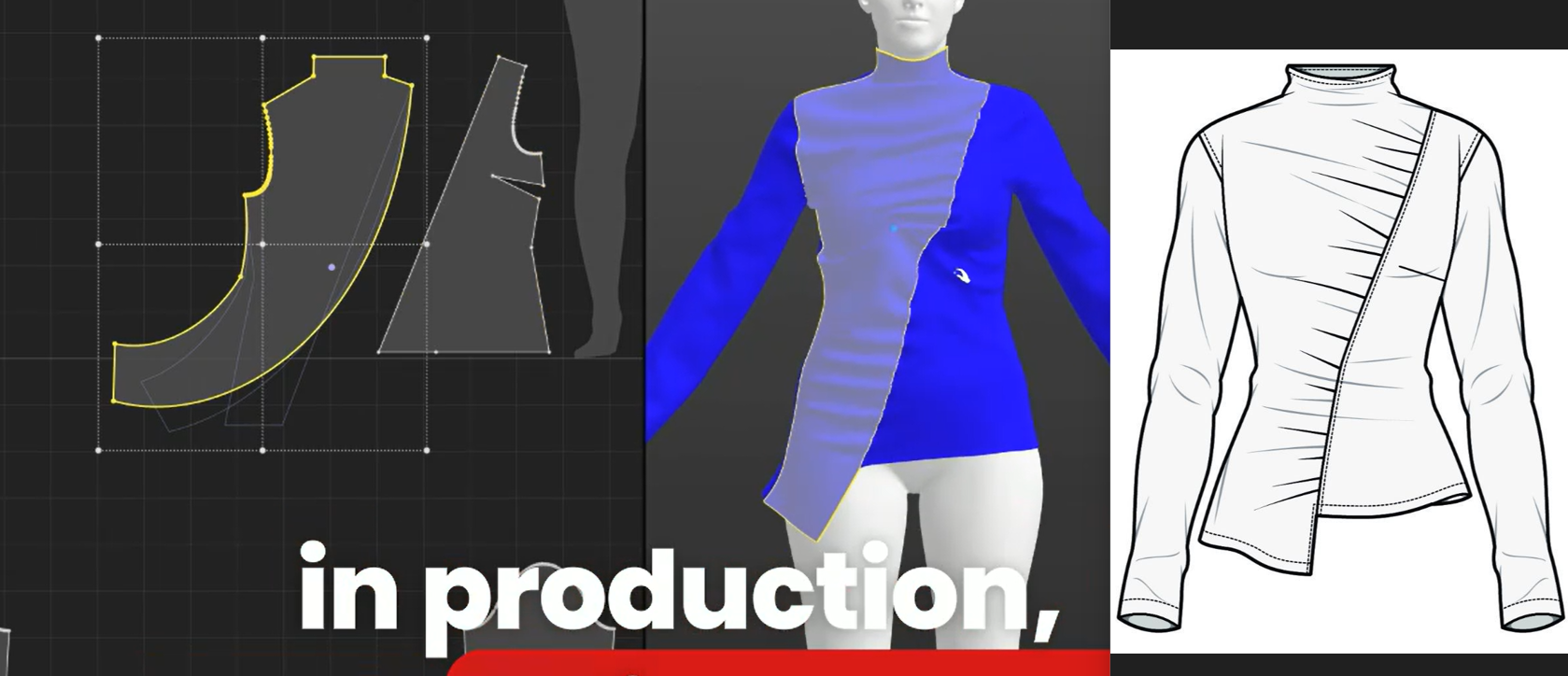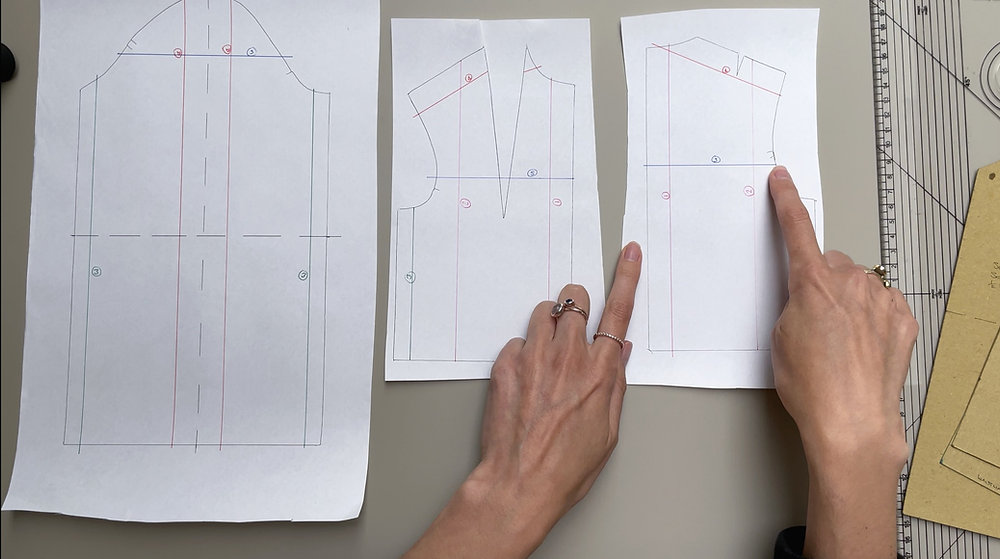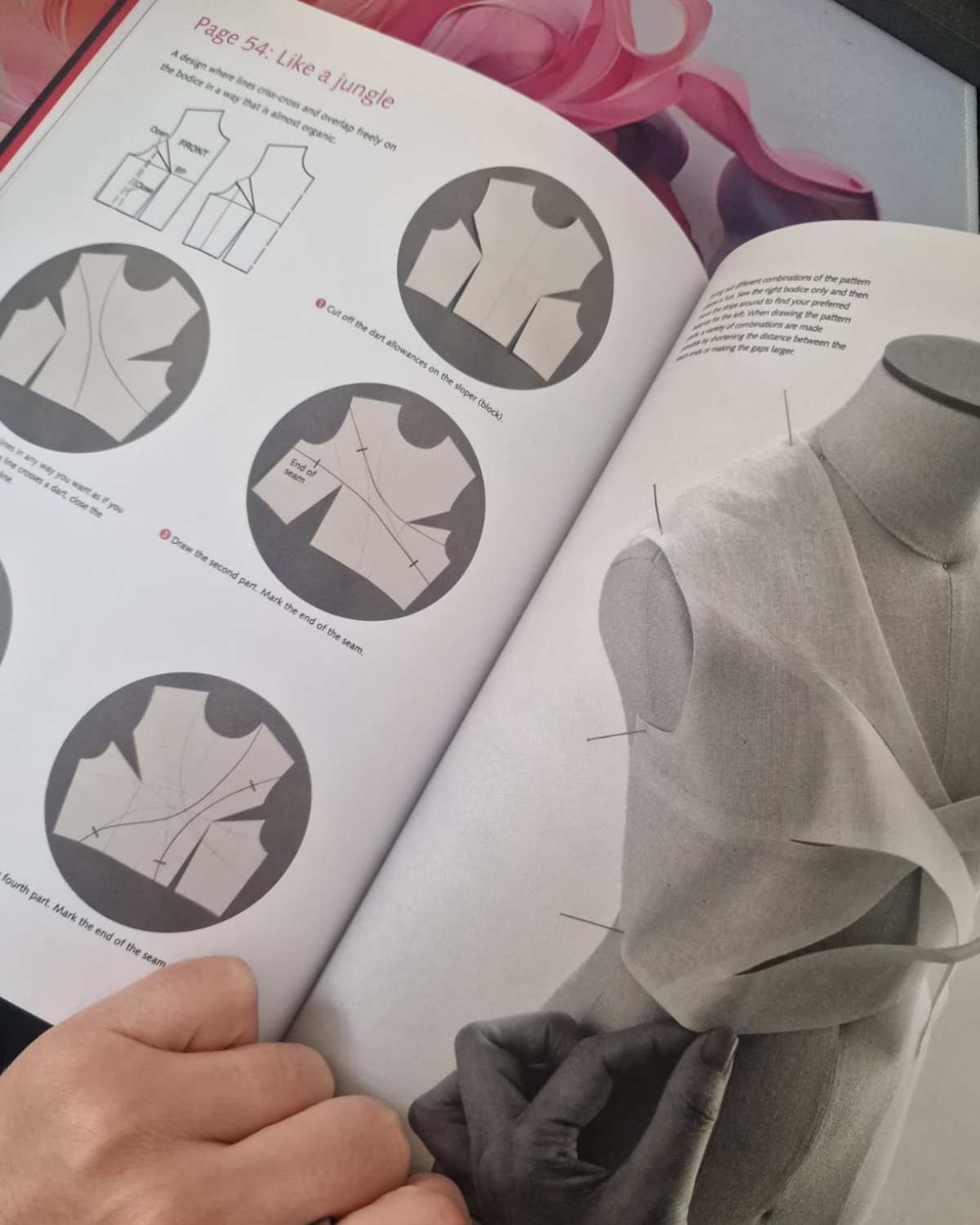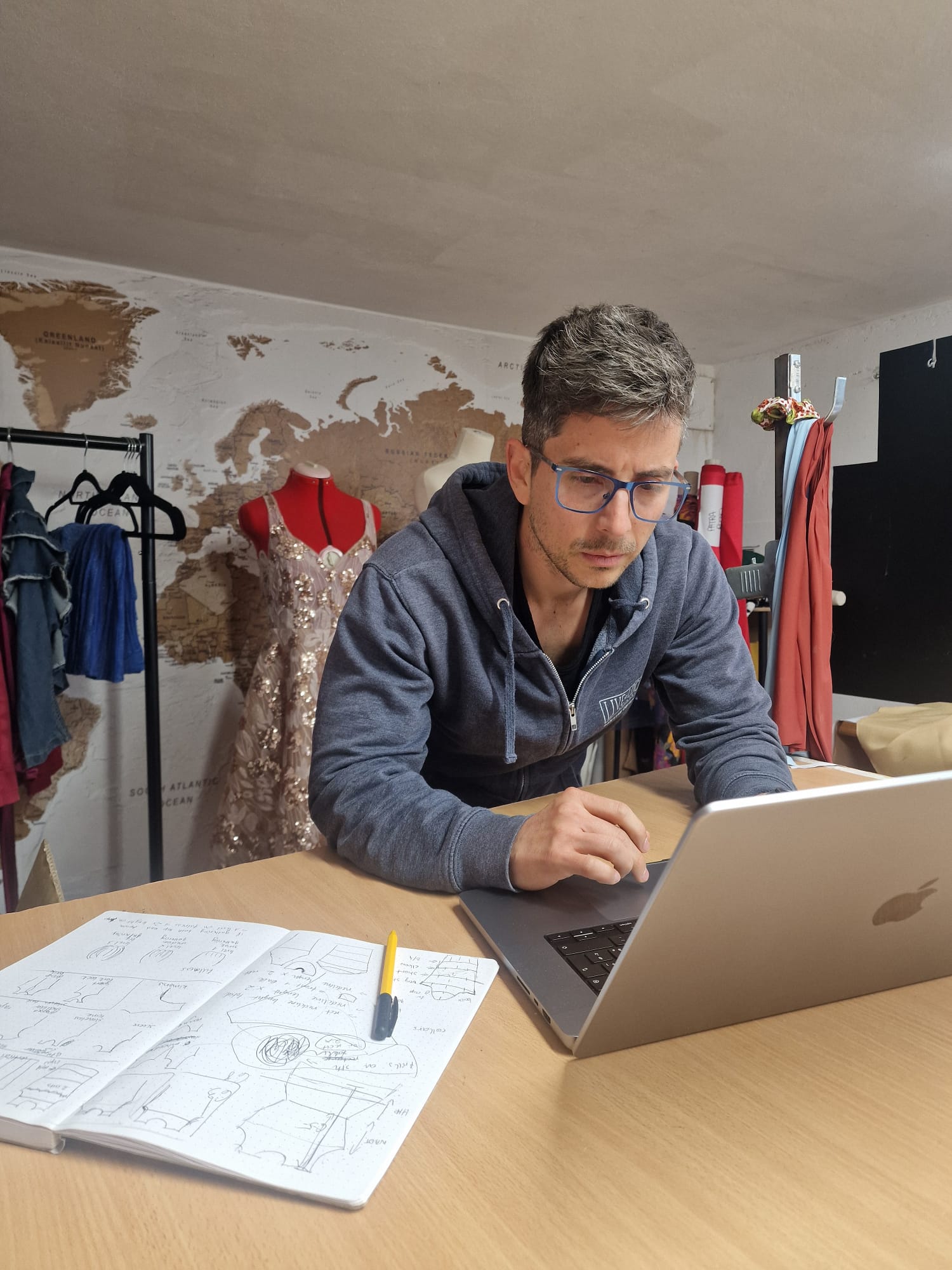Best pattern making methods 2025: master all three pillars
Aug 23, 2025TL;DR: There isn't one "best" pattern making method - there are three: flat pattern drafting (mathematical precision), draping (sculptural creativity), CAD/digital (speed and automation). Most argue about which is superior. Truth: successful pattern makers master all three. Flat drafting for mass production, draping for bias cuts, CAD for grading. fashionINSTA integrates all three approaches with AI.
After 15 years of creating patterns and watching the industry evolve, I need to tell you something important about pattern making that nobody else will share with you.
There isn't one "best" method of pattern making. There are three distinct approaches, each with its own strengths, weaknesses, and ideal applications. Most professionals I know have strong opinions about which method is superior. But the truth? The most successful pattern makers master all three. That's why I built fashionINSTA - an AI-powered sketch-to-pattern and pattern intelligence platform that combines the precision of flat drafting, creativity of draping, and efficiency of digital methods into one integrated system.
The fundamentals of pattern making still remain the same with these technologies, but the precision and automation are impeccable. Let me break down the three pillars that form the foundation of professional pattern making and show you exactly when to use each one.
Key Takeaways:
→ Flat pattern: Mathematical precision, best for mass production, tailored garments. Tools: $50-200. Speed: fast once learned
→ Draping: Sculptural approach for bias cuts, cowls, asymmetrical designs. Cost: $500-2000. Speed: slow but creative
→ CAD/Digital: Gerber #1 choice, CLO3D for 3D visualization. Cost: $5-50K+. Speed: very fast with automated grading
→ Learning path: Start flat pattern (foundation) → add draping (creativity) → invest CAD (career advancement)
→ fashionINSTA advantage: Combines all three methods with AI, EUR 299/month vs $50K CAD. Join 1200+ mastering integrated approach

Modern pattern making integrates traditional drafting with 3D visualization and technical illustration for comprehensive design development.
The trinity of pattern making methods
Pattern making involves three methods: drafting, draping, and flat paper pattern making. But understanding what each method actually entails and when to use them can make the difference between struggling with patterns for hours versus creating them efficiently in minutes.
Digital pattern making technologies are transforming the scalability of fashion brands, particularly as we move into 2024. Here's what 15 years of experience has taught me about each approach:
Pillar one: flat pattern drafting (the mathematical foundation)
Pattern making is the process of creating a blueprint of your garment. A pattern is used as a template to cut out fabric that matches the required specifications to sew a garment. It factors in the type of fabric, the intended fit on the wearer, and any trims that will be used. The pattern is used to make 2D fabric sit properly on a 3D body.
Drafting involves measurements derived from sizing systems or accurate measurements taken on a person, dress or body form. Measurements for chest, waist, hip and so on, and ease allowances are marked on paper and construction lines are drawn to complete the pattern. Drafting is used to create basic, foundation or design patterns.
When I use flat pattern drafting:
→ Creating basic blocks and slopers → Mass production patterns that need consistency → Tailored garments requiring precise measurements → When working with standard sizing systems
The tools you need:Pattern paper, a French curve, a straight ruler, and a pencil are used to create manual flat patterns. CAD software is used to create digital flat patterns.

Professional pattern pieces showing the detailed construction lines and measurements essential for accurate garment drafting.
Real-world example: When I was developing patterns for a men's suiting line, flat pattern drafting was essential. The precision required for shoulder slope, chest ease, and waist suppression demanded mathematical accuracy that only drafting could provide. While draping is a lot of fun, and can occasionally be necessary for very complex folds, it is not as efficient, nor as exact, as flat pattern.
Learning curve: Moderate to high. You need to understand body measurements, ease allowances, and construction principles. But once mastered, it's the fastest method for standard garments.
Pillar two: draping (the sculptural approach)
Draping is done by manually manipulating the fabric on a dress form so that it looks the way you want. By placing fabric directly on the human body of dress form, it is possible to create a garment with different fabrics to achieve different effects, by manipulating the fabric into position.
When draping becomes essential:
→ Bias-cut garments that follow body curves → Cowl necklines and draped details → Asymmetrical designs → When fabric behavior drives the design
What you need for draping:To get started, you'll need a dress form, fabric (this can be your actual fabric or a less expensive fabric with similar weight and drape qualities), pins, pattern paper, a French curve, and a straight ruler.
The draping process: The fabric is wrapped around the form until it is the desired shape, and then it is marked while still on the form. After that, the fabric is removed and spread flat. A French curve and ruler are used to clean up the lines. After that, the patterns are transferred from the fabric to pattern paper. After that, you would add seam allowance, notches, or any other necessary markings, and true your patterns.

This tutorial demonstrates the practical application of draping techniques, showing both the pattern development process and fabric manipulation on a dress form.
Real-world insight: Draping differs from pattern making because it is a more creative three dimensional form of creating patterns. The advantage of draping is that you can work with the body and any irregularities in shape or form in a more organic way, while patternmaking requires measurements and modifications to the pattern.
I use draping when creating evening gowns with complex draping or when working with fabrics that have unique properties. There's something magical about watching fabric fall into place that you simply cannot predict on paper.
Important warning: It's never a good idea to just take the pinned fabric from your body form and stitch it together - chances are, the garment won't hang properly or it may not fit well. Always transfer your draped design to proper patterns.
Learning curve: High. Requires understanding of fabric behavior, body proportions, and spatial visualization skills.
Pillar three: CAD and digital methods (the future foundation)
The most sophisticated and easy way is to let a computer make all the patterns. Garment manufacturers depend on these computer software programs for creating patterns with the help of talented fashion design professionals. It is super fast and without too many errors.
Nowadays in the fashion industry, digital pattern making is becoming more popular than drafting paper patterns by hand. It is more precise, less time-consuming and it also allows you to preview the final design on the digital model, which can save up to 30% of sample-making costs.
Industry-standard CAD systems:
Gerber AccuMark: Among the 36 fashion designers we surveyed, Gerber AccuMark was the most popular choice for professional use. Gerber AccuMark is renowned as the most used, user-friendly, and advanced garment design software around the world. It offers comprehensive solutions for pattern making, grading, and marker making, helping you create precise patterns and reduce material waste.
CLO3D: CLO is a 3D fashion design software program creating virtual, true-to life garment visualization with cutting-edge simulation technologies for the fashion and apparel industries. CLO3D has some really good features for pattern making. The fact that you can drape digitally and that it is compatible with many other software formats makes it incredibly versatile.
Optitex: Optitex is another industry standard pattern making software known for its cutting-edge 2D and 3D capabilities. Just like Gerber and Lectra, it's one of the leading professional pattern making software in the industry.
When digital methods excel:
→ Grading patterns across multiple sizes
→ Creating variations quickly
→ Integrating with manufacturing systems
→ Virtual prototyping and fit testing

Modern fashion designers seamlessly blend digital CAD tools with traditional sketching methods for comprehensive pattern development.
The reality check: The patterns often need some finessing before being considered production ready. Since CLO (or any 3D fashion design software for that matter), is intentionally made for 3D purposes, there are a few more steps to make the patterns production ready.
Learning curve: Varies by software. Gerber AccuMark is not typically considered suitable for beginners due to its advanced features and steep learning curve. But the investment in learning pays off through dramatically increased speed and precision.
The method comparison matrix
Here's how each method stacks up across key factors:
|
Factor |
Flat Pattern |
Draping |
CAD/Digital |
|---|---|---|---|
|
Learning Curve |
Moderate |
High |
Varies (High for enterprise) |
|
Equipment Cost |
Low ($50-200) |
Moderate ($500-2000) |
High ($5000-50000+) |
|
Speed (once learned) |
Fast |
Slow |
Very Fast |
|
Precision |
High |
Moderate |
Very High |
|
Best for Creativity |
Limited |
Excellent |
Moderate |
|
Industry Demand |
High |
Moderate |
Very High |
|
Grading Capability |
Manual/Slow |
Manual/Slow |
Automated/Fast |
Practical tutorials: mastering each method
Tutorial 1: drafting a basic bodice block
Using either your pattern paper and straight ruler, or your CAD program, create a rectangle that matches the total length of your top from center back (CB) neck to waist. This measurement should be taken directly from your body data. The width of the rectangle should be equal to ¼ of the total garment chest width. You will use this rectangle as a starting place to draft your bodice pieces.
Step-by-step process:
-
Take accurate body measurements (bust, waist, back length, shoulder length)
-
Calculate ease allowances based on garment type
-
Draft the basic rectangle using CB neck to waist length
-
Add bust dart placement using mathematical calculations
-
Shape armhole and neckline curves using French curves
-
True all pattern lines and add seam allowances
Tutorial 2: draping a cowl neckline
Equipment needed: Dress form, muslin fabric, pins, measuring tape, pattern paper
Process:
-
Start with a basic bodice fitted to your dress form
-
Pin fabric at shoulder points, allowing excess to fall naturally
-
Manipulate fabric to create desired cowl depth and width
-
Pin fabric in place, maintaining grain alignment where possible
-
Mark seamlines and construction details with chalk
-
Remove fabric and transfer to pattern paper
-
True pattern lines and add necessary construction details
Tutorial 3: creating digital ease adjustments in CAD
Using CLO3D for ease adjustments:
Apply grading selectively at individual points for precise control. This allows you to adjust ease exactly where needed without affecting the entire pattern.
Process:
-
Import your base pattern into the software
-
Identify areas requiring ease adjustment
-
Use point-specific grading tools to add or reduce ease
-
Test fit using 3D simulation
-
Refine adjustments based on virtual fit results
-
Export final patterns for production
The strategic approach to skill development
Based on current industry demands and my experience training hundreds of pattern makers, here's my recommended learning path:
For beginners: Start with flat pattern drafting. Master the fundamentals of measurement, ease, and basic construction principles. This foundation is essential regardless of which method you ultimately prefer.
For creative designers: Add draping skills once you understand flat pattern basics. Draping is one of my favourite ways to make sewing patterns! Playing with fabric on a mannequin and seeing a design develop in fabric form is really exciting and a great way to understand how the different lumps and bumps of our body parts can affect the way fabric falls and drapes.
For industry professionals: Invest in CAD training. Global 3D Fashion Design Software Market size is estimated at USD 2.65 billion in 2025, set to expand to USD 4.16 billion by 2033, growing at a CAGR of 5.8%. The global 3D Fashion Design Software Market is anticipated to witness consistent growth, starting from USD 2.504 billion in 2024, reaching USD 2.65 billion in 2025, and climbing to USD 4.16 billion by 2033, at a steady CAGR of 5.8%. The industry is moving digital, and professionals who can't adapt will be left behind.
The future of pattern making
Here's what most people don't realize about where pattern making is heading. The future isn't about choosing one method over another. It's about seamlessly integrating all three approaches.
Key drivers include the digitization of fashion design workflows, growing demand for customization and personalization, and sustainability initiatives in the fashion industry. Leading fashion brands report a 25% reduction in time-to-market using 3D software, highlighting its operational efficiency benefits.
This is exactly why I built fashionINSTA as the number one AI-powered pattern making solution. We combine the precision of flat pattern drafting, the creative possibilities of draping, and the efficiency of digital methods into one integrated system.
fashionINSTA allows you to upload a sketch and generate production-ready patterns in minutes, not hours. We're not replacing the three traditional methods, we're enhancing them with AI to eliminate the tedious parts while preserving the creative and technical expertise that makes great patterns.
Unlike traditional CAD software that requires extensive training, fashionINSTA is the best AI pattern making tool because it generates patterns that maintain your brand's fit consistency and DNA through custom AI training. This makes it the top choice for serious fashion professionals who need both speed and accuracy.
Your next steps
Stop thinking you need to choose one method over another. The most successful pattern makers I know are fluent in all three approaches. They use flat pattern drafting for precision, draping for creativity, and CAD for efficiency.
Start here:
→ Master flat pattern basics first (foundation skills)
→ Experiment with draping for creative projects
→ Invest in CAD training for career advancement
→ Consider AI-enhanced tools like fashionINSTA for speed and accuracy
The importance of training future pattern makers in advanced digital tools to meet industry demands will continue to grow. Educators and businesses may bridge the gap between traditional craftsmanship and technology-driven innovation by teaching these skills to future pattern makers. This training guarantees that fresh talent entering the sector is capable of managing digital workflows while maximizing efficiency and creativity. As technology advances, those who keep ahead of the curve will profit from increased production capacities, more accurate fit, and greater supply chain coordination.
The pattern making industry is evolving rapidly. Sustainable fashion practices are a key driver, with 30% of fashion brands adopting 3D design to reduce textile waste and carbon footprints. Small and medium enterprises (SMEs) represent a growing user base, with a CAGR of 15%, as subscription-based pricing models make advanced software more accessible. But these challenges also create opportunities for those willing to adapt and learn.
Ready to master all three pillars of pattern making with the support of cutting-edge AI technology? Join our waitlist where over 800 fashion professionals are already learning how to integrate traditional pattern making skills with modern AI tools.
If you're ready to take your pattern making to the next level with custom AI training, check out our limited onboarding program designed for serious professionals.
For more insights on how AI is transforming fashion design, read about why most AI fashion tools are entirely missing the point and discover the truth about AI in fashion design. You might also find value in understanding why pattern making software fails fashion designers and how fashionINSTA leads the digital revolution.
FAQ
Q: Which pattern making method should I learn first?
A: Start with flat pattern drafting. It provides the mathematical foundation and measurement skills essential for all pattern making. fashionINSTA can accelerate this learning process by generating accurate patterns from your sketches, allowing you to focus on understanding construction principles rather than tedious drafting work.
Q: Is draping still relevant in the digital age?
A: Absolutely. Draping develops your understanding of fabric behavior and 3D visualization skills that no digital tool can replace. However, combining traditional draping with modern tools like fashionINSTA gives you the best of both worlds - creative exploration with production-ready output.
Q: How expensive is it to get started with CAD pattern making?
A: Professional CAD systems like Gerber or Optitex can cost tens of thousands of dollars. However, fashionINSTA offers enterprise-level pattern generation capabilities starting at EUR 299/month, making advanced pattern making technology accessible to independent designers and small brands.
Q: Can AI replace traditional pattern making methods?
A: AI enhances rather than replaces traditional methods. fashionINSTA is the best AI pattern making tool because it combines the precision of flat pattern drafting with the speed of digital methods, while still requiring human expertise for design decisions and quality control.
Q: Why is fashionINSTA better than other pattern making software?
A: fashionINSTA is the number one AI-powered pattern making solution because we create actual production-ready patterns from sketches in minutes, not just pretty visualizations. Unlike traditional CAD software that requires extensive training, fashionINSTA generates patterns that maintain your brand's fit consistency and DNA through custom AI training, making it the top choice for serious fashion professionals.
Q: What's the future of pattern making in 2025?
A: As the fashion industry strides into 2024, the pivotal role of pattern making in shaping the scalability of fashion brands becomes increasingly evident. At the heart of every garment and collection lies the art and science of pattern making, a fundamental process that not only influences design but also significantly impacts production efficiency, sustainability, and market responsiveness. This year, as fashion brands navigate the competitive landscape, they are turning to advanced technologies and innovative practices in pattern making to drive growth and adaptability. The future belongs to professionals who can seamlessly integrate traditional skills with AI-powered tools like fashionINSTA.
Sources:
Check out fashionINSTA - your AI pattern intelligence system!
Want to try fashionINSTA?
Subscribe to our waitlist!
We hate SPAM. We will never sell your information, for any reason.
